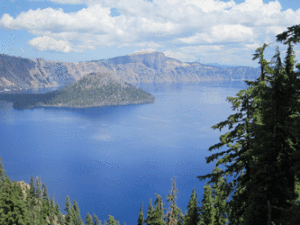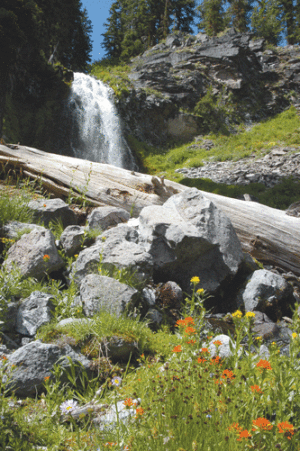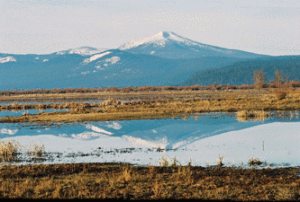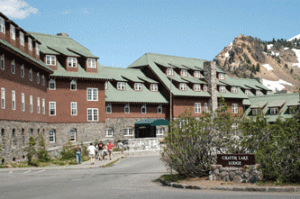Crater Lake National Park surrounds the deepest lake in the United States, and may soon have insufficient water supplies for its public operations.
State water regulations in the Klamath Basin have begun shutting off farmers’ and ranchers’ water for the first time — and could extend shutoffs to public lands including Crater Lake.
The clear, mirror-like reflective lake is protected and therefore its waters are not used for park operations. Instead, the park draws 69,000 gallons of water daily from nearby streams, according to Jeff Olson, spokesman for the National Park Service.
About half a million visitors come to Crater Lake National Park each year. The park uses the majority of its water for domestic uses such as showers and meals at the historic Crater Lake Lodge and the visitor’s center.
The main source of water is Annie Creek, a tributary to the Wood River. Within the next couple of weeks, state regulations are expected to turn off the spigots of all water users who aren’t at the top of the priority list.
And Crater Lake is 27th on the priority list for Wood River water users, according to Michael Hughes, director of Oregon Institute of Technology’s environmental sciences program.
“A likely scenario is the park would be shut off and there’s no plan to handle that. It could be super explosive. It has international implications because people come to Crater Lake from all over the world. If visitors come from China and they have reservations at the lodge — tough luck.”
Crater Lake National Park superintendent Craig Ackerman declined to comment for this story.
Economic impacts
Any impacts to Crater Lake could be far-reaching economically. In 2011, visitors contributed $34.6 million to nearby communities, said Jeff Olson, National Park Service spokesman, and 549 area jobs were supported.
Given a stagnant regional economic landscape, any interruption in park operations could have ripple effects. Recent federal sequester cuts already trimmed 5 percent from the park’s annual budget, delaying programs and leaving positions unfilled.
Priority list
Why is Crater Lake National Park so low on the priority list of water users? A contentious, 38-year legal process has resulted in the Klamath Basin’s first regulated (adjudicated) water season. That, mixed with a drought and a recent call for water by more senior water rights, is a perfect storm for shutting off junior water rights, including the park.
Crater Lake National Park was established in 1902, which determines the main priority date for its water rights. Western water law establishes senior and junior rights based on the earliest uses of water.
Calls for water were made June 10 by the most senior water rights holders: Klamath Project farmers and the Klamath Tribes.
Generally speaking, calls for water are calls for an amount of water. Senior rights guarantee a certain amount of water, and local watermaster Scott White is regulating that by shutting off some junior water users.
Shutoffs so far
In the current drought year, White expects water users to be affected on every river and stream in the upper Klamath Basin. So far, he has shut off users along the Sprague River and recently started on the Williamson. The Wood River system, including Annie Creek, will follow in the next couple weeks.
Doug Woodcock of the Oregon Water Resources Department said Crater Lake is a water user like anyone else.
“The watermaster regulates by priority and not by use,” Woodcock added. “We’re getting a lot of calls from folks saying, ‘Wait a minute, I’m not an irrigator.’ This isn’t about how you use your water. It’s the fact that you do divert water.”
It may be surreal to imagine a national park with an average snowfall of nearly 45 feet and a lake 1,943 feet deep losing its water source. Yet park officials are not ruling out the possibility.
“Like our neighbors across the Klamath Basin, the National Park Service is developing contingency plans to operate Crater Lake National Park with limited water service this summer,” Olson said.
“Our highest priorities are to protect park resources, ensure safety, and to limit impacts to park visitors, employees, partners and local businesses.”
Limitations
Hughes says the Park Service knew this might be on the horizon for years, although its federal status creates certain limitations.
“They’ve tried to lease and purchase water rights, but they can’t legally pay above market value,” Hughes said. “There is a federal law that would prevent them from paying above the market price for a water right.”
The environmental sciences professor thinks there’s at least a 50 percent chance the park will lose some or all of its water.
“If this happens and we can’t use the lodge or the visitor’s center it would probably happen once, and only once. And somebody would be compelled to make a legal or policy solution to make sure water could be obtained,” Hughes said.
The issue isn’t necessarily a done deal in a Congress that recently failed to pass a farm bill.
2001 shutoffs
When you speak of water regulation in the Klamath Basin, many picture the 2001 water shutoffs of Klamath Project farms, and recent shutoffs of upper Basin irrigators.
The image likely doesn’t extend to one of the world’s iconic natural wonders and the 182,000-acre national park surrounding it. At least not yet.
“The Klamath Basin is a testing ground for virtually everything that’s going on with water allocations in the American West,” said Hughes. “And to my knowledge, particularly with the Park Service aspect, it’s unprecedented.”




